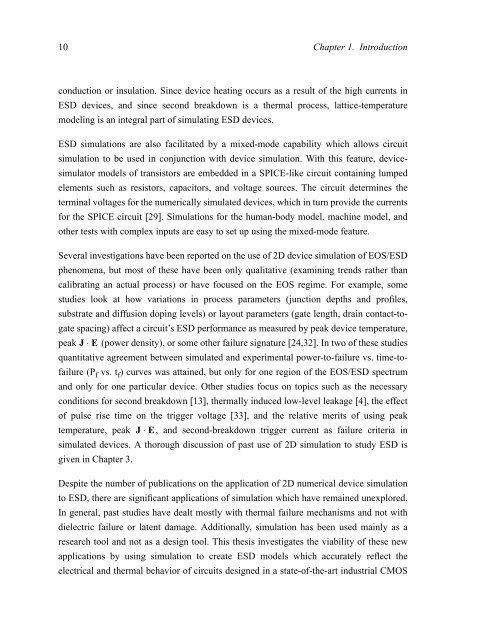characterization, modeling, and design of esd protection circuits
characterization, modeling, and design of esd protection circuits
characterization, modeling, and design of esd protection circuits
You also want an ePaper? Increase the reach of your titles
YUMPU automatically turns print PDFs into web optimized ePapers that Google loves.
10 Chapter 1. Introduction<br />
conduction or insulation. Since device heating occurs as a result <strong>of</strong> the high currents in<br />
ESD devices, <strong>and</strong> since second breakdown is a thermal process, lattice-temperature<br />
<strong>modeling</strong> is an integral part <strong>of</strong> simulating ESD devices.<br />
ESD simulations are also facilitated by a mixed-mode capability which allows circuit<br />
simulation to be used in conjunction with device simulation. With this feature, devicesimulator<br />
models <strong>of</strong> transistors are embedded in a SPICE-like circuit containing lumped<br />
elements such as resistors, capacitors, <strong>and</strong> voltage sources. The circuit determines the<br />
terminal voltages for the numerically simulated devices, which in turn provide the currents<br />
for the SPICE circuit [29]. Simulations for the human-body model, machine model, <strong>and</strong><br />
other tests with complex inputs are easy to set up using the mixed-mode feature.<br />
Several investigations have been reported on the use <strong>of</strong> 2D device simulation <strong>of</strong> EOS/ESD<br />
phenomena, but most <strong>of</strong> these have been only qualitative (examining trends rather than<br />
calibrating an actual process) or have focused on the EOS regime. For example, some<br />
studies look at how variations in process parameters (junction depths <strong>and</strong> pr<strong>of</strong>iles,<br />
substrate <strong>and</strong> diffusion doping levels) or layout parameters (gate length, drain contact-togate<br />
spacing) affect a circuit’s ESD performance as measured by peak device temperature,<br />
peak J ⋅ E (power density), or some other failure signature [24,32]. In two <strong>of</strong> these studies<br />
quantitative agreement between simulated <strong>and</strong> experimental power-to-failure vs. time-t<strong>of</strong>ailure<br />
(Pf vs. tf ) curves was attained, but only for one region <strong>of</strong> the EOS/ESD spectrum<br />
<strong>and</strong> only for one particular device. Other studies focus on topics such as the necessary<br />
conditions for second breakdown [13], thermally induced low-level leakage [4], the effect<br />
<strong>of</strong> pulse rise time on the trigger voltage [33], <strong>and</strong> the relative merits <strong>of</strong> using peak<br />
temperature, peak J ⋅<br />
E,<br />
<strong>and</strong> second-breakdown trigger current as failure criteria in<br />
simulated devices. A thorough discussion <strong>of</strong> past use <strong>of</strong> 2D simulation to study ESD is<br />
given in Chapter 3.<br />
Despite the number <strong>of</strong> publications on the application <strong>of</strong> 2D numerical device simulation<br />
to ESD, there are significant applications <strong>of</strong> simulation which have remained unexplored.<br />
In general, past studies have dealt mostly with thermal failure mechanisms <strong>and</strong> not with<br />
dielectric failure or latent damage. Additionally, simulation has been used mainly as a<br />
research tool <strong>and</strong> not as a <strong>design</strong> tool. This thesis investigates the viability <strong>of</strong> these new<br />
applications by using simulation to create ESD models which accurately reflect the<br />
electrical <strong>and</strong> thermal behavior <strong>of</strong> <strong>circuits</strong> <strong>design</strong>ed in a state-<strong>of</strong>-the-art industrial CMOS
















